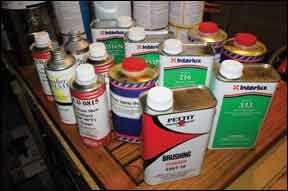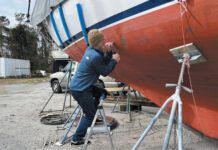I am restoring old fiberglass sailing club boats (Rhodes 19s) in a confined, heated space in winter, and I need to paint the topsides, decks, and bilges without poisoning the applicator. What do you suggest for a topside finish (white)? A repairable, long-lasting finish will be valued more than a high-gloss finish.
Also, what do you suggest for the bottom paint? The boats will be in fresh water all summer; low environmental toxicity is a high priority.
Dave Mankus
Rhodes 19
Wolfeboro, N.H.
The solvents in most antifouling and topside paints are extremely noxious, making applying them in a confined space dicey, especially if the space is heated. The first order of business is to invest in high-quality, properly fitted masks and respirators-if you can smell the solvents, it is not properly fitted. If the space is truly confined and enclosed, an air-fed hood is worth considering.

For topside paint, your best bet would be a do-it-yourself, two-part linear polyurethane (LPU) like Interlux Perfection. LPUs offer a scratch-resistant, repairable finish that would hold up well to club-sailing use. They can be sprayed on or roll-and-tipped. Perfection performed well during our test-boat application (PS, August 2009) and panel tests (PS, December 2012), but its fumes are at the very high end of the spectrum.
If you choose a two-part LPU, spraying it on is recommended. The method is faster, requiring the applicator(s) to spend less time around the solvent fumes, but indoor spraying does have risks. Professionals who do it use explosion-proof lighting, extraction blowers, and sometimes spray booths. Check out the online version of this article for tips on DIY spray painting.
If you plan to have the finish rolled or brushed on, a one-part product like Interlux Toplac or Brightside, Pettit EasyPoxy, or Epifanes Monourethane would be better choices. The easily repairable finishes wont be as hard as a two-part, but their fumes are much more tame. According to Interlux and Epifanes, a one-part would be the safest route.
For a freshwater, eco-friendly antifouling, we recommend Interluxs VC17m. Although it hasn’t fared well in our saltwater panel tests, VC17m is often recommended by PS readers who are freshwater racing sailors. It dries extremely quickly and can be applied just before launching, making it a good choice for you.
Here are a few tips from paint makers that we consider must-follow advice:
-Do NOT use kerosene heaters to heat the space; kerosene puts moisture and other contaminants in the air that make it difficult to get a good finish. If you must use kerosene, turn heaters off 30 minutes before you paint.
-Electric heaters would be best, but they should be turned off before painting, and wait at least 30 minutes after painting to turn them back on. ? Pick a time when the temperature is steady, not forecast to drop or rise rapidly.
-Some solvents are heavier than air, and they can replace the oxygen around you, so its possible to end up in an oxygen-free environment, especially in bilges. Do not paint alone. At the very least, have someone check on you every five to 10 minutes; if you feel dizzy, get to fresh air immediately.



































